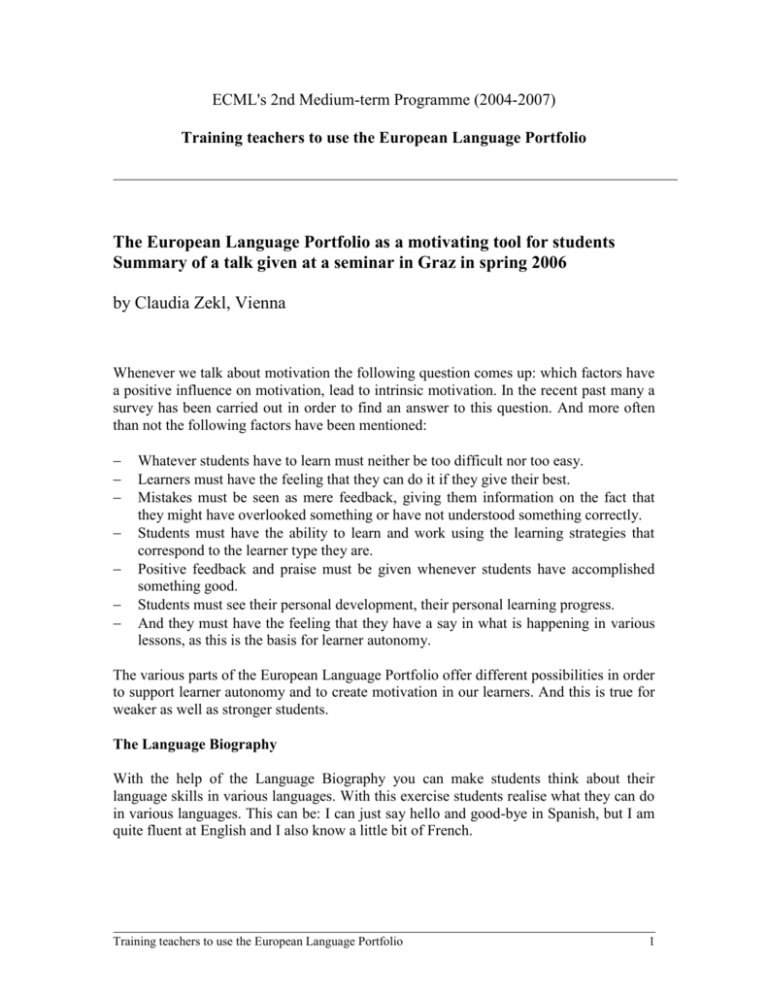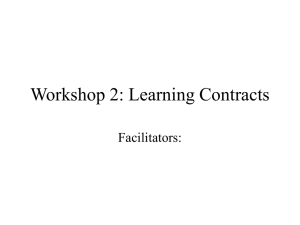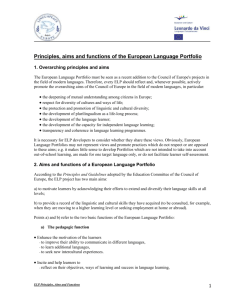Summary of a talk
advertisement

ECML's 2nd Medium-term Programme (2004-2007) Training teachers to use the European Language Portfolio The European Language Portfolio as a motivating tool for students Summary of a talk given at a seminar in Graz in spring 2006 by Claudia Zekl, Vienna Whenever we talk about motivation the following question comes up: which factors have a positive influence on motivation, lead to intrinsic motivation. In the recent past many a survey has been carried out in order to find an answer to this question. And more often than not the following factors have been mentioned: Whatever students have to learn must neither be too difficult nor too easy. Learners must have the feeling that they can do it if they give their best. Mistakes must be seen as mere feedback, giving them information on the fact that they might have overlooked something or have not understood something correctly. Students must have the ability to learn and work using the learning strategies that correspond to the learner type they are. Positive feedback and praise must be given whenever students have accomplished something good. Students must see their personal development, their personal learning progress. And they must have the feeling that they have a say in what is happening in various lessons, as this is the basis for learner autonomy. The various parts of the European Language Portfolio offer different possibilities in order to support learner autonomy and to create motivation in our learners. And this is true for weaker as well as stronger students. The Language Biography With the help of the Language Biography you can make students think about their language skills in various languages. With this exercise students realise what they can do in various languages. This can be: I can just say hello and good-bye in Spanish, but I am quite fluent at English and I also know a little bit of French. Training teachers to use the European Language Portfolio 1 On the basis of this students can brainstorm the things they can do with languages in certain situations. In the course of this activity students realise that languages fulfil different tasks, that different languages are sometimes used for different purposes, that it is easier to express some things in the mother tongue and other things in a foreign language. Using all this information students can answer the following questions: What does it mean (for me/in general) to know a certain language? In which situations is it important to speak as perfectly and fluently as possible? … This raises students’ awareness with regards to the quality of their own language performance. Lists of Can-do-Statements Can-Do-Statements help the students estimate their personal language skills. Teachers can tell their students where they are expected to be, e.g. at A2 in a first year of a vocational school and where they are expected to be at the beginning of the next school year, e.g. at A2+/B1. Then the students can have a look at the various Can-do-Statements describing the respective level and tick off the things they are sure they can do in the respective language. Finally they can use the other Can-do-Statements in order to set themselves personal learning aims. This is a also a good strategy if teachers want to make learning aims that are set by the ministry of education personal learning aims of students. But students have to be careful with the way they formulate their learning aims. A learning aim must always be worded in a positive way. A sentence like “I don’t want to make so many mistakes in future” is not very useful. the students find out if they have reached their aim or not. and what they still have to learn. Then they must think about where they might get assistance, additional exercises, … from. take the respective steps themselves. They should never ever make somebody or certain circumstances responsible for their success. Training teachers to use the European Language Portfolio 2 successes now and then which they need to stay motivated and to see their personal progress. The Dossier In the course of a school year students accomplish various tasks: write essays or articles, do certain exercises, …. The dossier is the place where they can store their best products as well as those which are very dear to them, which mean a lot to them. It is always interesting to ask students why they decided to put a certain essay, letter, exercise, … into their dossier. Answers can for example be: it’s the first longer text that I have produced in the foreign language, I did not make many mistakes, It is a text about myself. Whenever students hand in their work they have to receive feedback. This feedback need not always come from the teacher. Also peers can learn how to correctly say their opinion on a classmate’s piece of work. Whenever they are asked to do so they should remember to start their feedback with a positive remark, then mention ONE thing their colleague could concentrate on in case he/she wants to improve his/her language skills, and then they should end with a final positive remark. This helps especially weaker students accept some kind of criticism and shows them where they could start working if they want to get a better mark and have more fun with learning the respective language. As you can see every part of the European Language Portfolio offers ways to evaluate one’s language skills, to set learning aims and to bridge gaps in one’s knowledge as well as improve one’s skills. And what is more, students can follow their own individual way starting out with the knowledge they have and improving their language skills step by step. For weaker students this would mean to ascertain the status quo, to think about their personal learning strategy as well as factors that help or hinder them in learning a certain language, and then searching for ways of how to set themselves aims to bridge gaps in their knowledge, to develop a successful learning strategy and to create their personal story of success. For stronger students this would mean to ascertain the status quo, to find out where there are opportunities to set themselves learning aims according to their personal interests and talents and to find ways of how to reach them. This could also mean that they work on a certain topic, project, … while the other students are practising e. g. certain grammar structures, vocabulary, … and that they then put together a presentation on their findings and show it to the other students in class. Training teachers to use the European Language Portfolio 3 Summing up we can say that the European Language Portfolio is a perfect means for individualisation, for recognizing each student’s needs and for supporting each student in a very personal way. Training teachers to use the European Language Portfolio 4









